This year, there are many embroidery-related books being published. Search Press alone has over twenty coming out in 2020, and there are other publishing houses with some notable works on tap for 2020, too. It’ll be a banner book year!
One of the books that I’m really looking forward to is Embroidered Boxes by Heather Lewis. I have a thing for box making – though not always out of embroidery. Fabric and paper covered boxes are fun and a bit quicker than embroidered boxes, and the techniques carry over into any method of decor that you want to use on a box.
For those of you who are intrigued by “cartonnage” – the craft of creating boxes covered with fabric, paper, or embroidered fabric – I thought I’d introduce you to some of my favorite books and chat a bit about box-making in general.
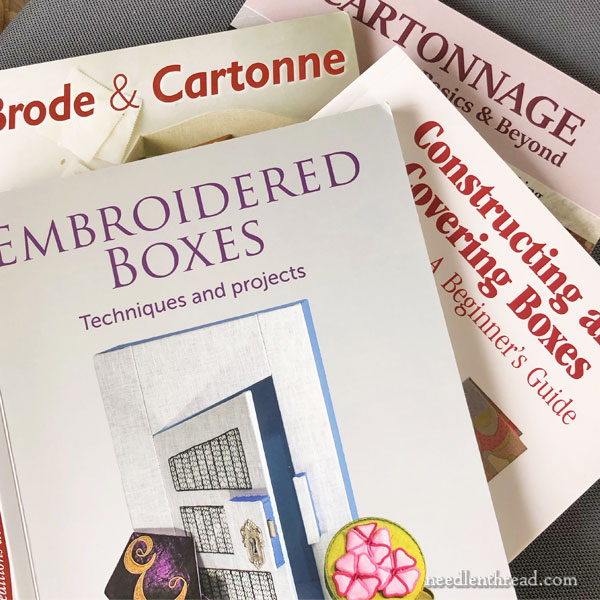
Here are a few of my box-making books. I’ve also got some older books on the subject – I wrote about one of them that I really like here.
The top book on the pile above, Embroidered Boxes: Techniques & Projects, I’ve already reviewed here on Needle ‘n Thread, too, if you want to know detailed information about that book.
It’s an excellent book!
But the other books – especially two of them that don’t actually deal with embroidered boxes – are so thorough when it comes to the actual construction part of box making, that I think they’re even more helpful when it comes to understanding the nuances of making boxes.
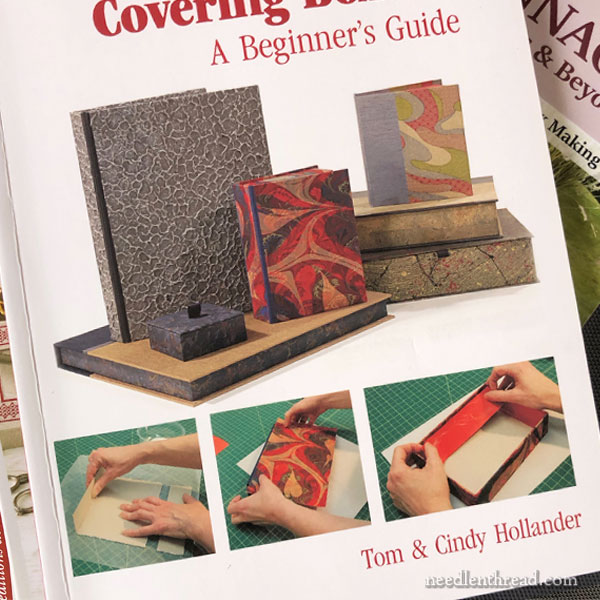
The Hollander book – Constructing & Covering Boxes: The Art of Box Making, by Tom and Cindy Hollander – is now in its second edition.
The book focuses on constructing boxes that are covered with paper, primarily. It is a technical book, very thorough, with patterns and step by step instructions for making boxes.
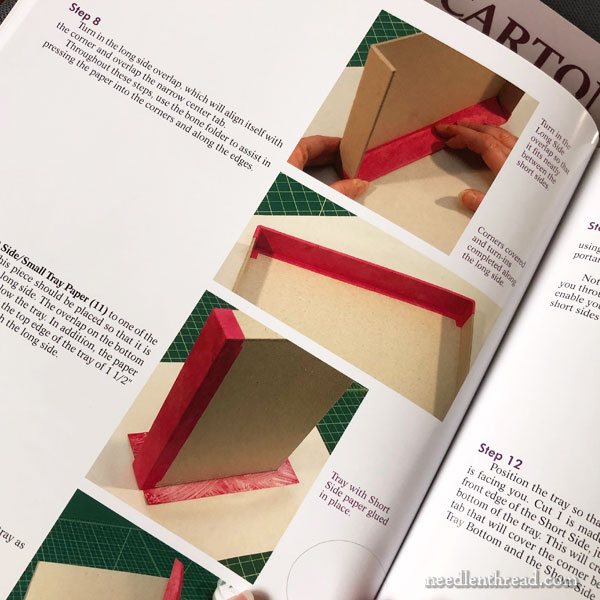
If you’re a beginner, you’ll appreciate the step-by-step instructions. They also take it further with more advanced techniques, too, so there’s something for everyone in this book.
If you’re into bookbinding, you might be familiar with the Hollander’s website, Hollander’s. They offer all kinds of book-binding (and box-making) supplies, along with kits and information on their workshops and so forth.
In any case, this is a really good book to have in your box-making arsenal, and it will teach you fundamentals for building boxes, whether they’re embroidered or not.
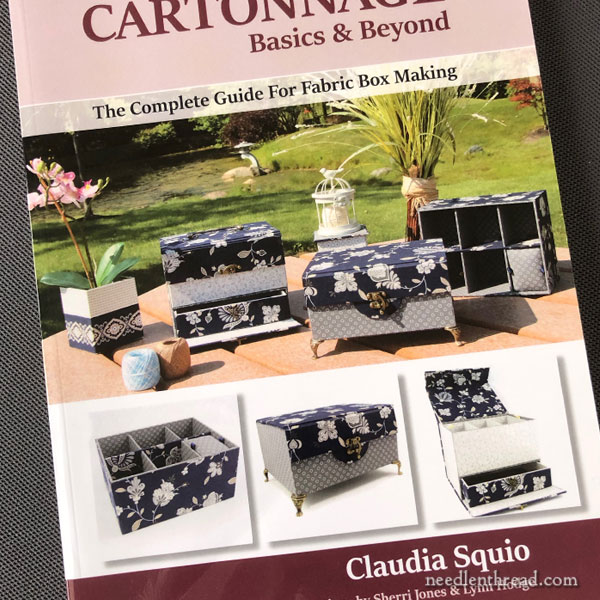
Cartonnage Basics & Beyond: The Complete Guide for Fabric Box-Making by Claudia Squio is pretty much her master course in making fabric covered boxes, and it is a must if fabric boxes are on your radar.
Claudia pretty much has a whole empire built around making fabric-covered boxes. She has a website – Colorway Arts – with tutorials, and she sells kits and whatnot – she is a rabbit hole unto herself, if you are exploring the whole world of making fabric-covered boxes.
She offers a free online class for box making on her learning website, which you can find here, as well as several in-depth online classes for a fee.
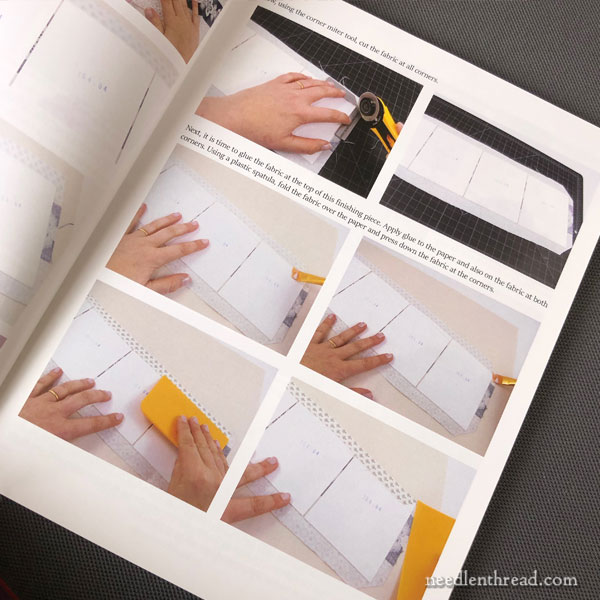
Her book, though, will get you going just fine, and from there, you can see if you want to go deeper with box making.
The instructions in the book are thorough, clear, step-by-step instructions. The book starts with simpler boxes and moves to more complex boxes with compartments, drawers, trays, and so forth.
Between this and the Hollander book, all your box-making bases are covered, when it comes to construction. If you’re oscillating between the two books and only one is an option, I’d go with the Squio book.
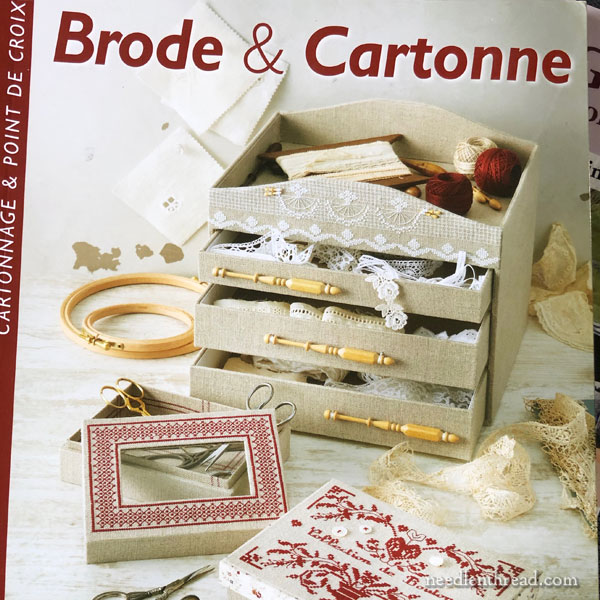
There’s one more book in the stack – Brode & Cartonne – which actually does deal specifically with making boxes with embroidery on them.
This book is in French, but it has some good photo instructions and it’s a nice source for inspiration. The embroidery is all cross stitch, and the charts are included.
Cartonnage is popular in France, and you’ll find a heap of French books devoted to the subject, whether the boxes are embroidered or fabric-covered. The French style is quite clean and classic, and I like the look of their boxes, trays, compartments, stationary sets, and innumerable other box-like structures that they explore.
This book is not as detailed as the Hollander and Squio books in the actual construction, but it does have step-by-step photos of the basics and it is a nice source for inspiration.
The Basics of Box Making
The Hollander and Squio books will give you all the principles of box-making and covering, and those principles are essential, whether you’re covering boxes with paper, fabric, or embroidered fabric.
One difference that will stand out, though, between box making with embroidered fabric and the box making with paper or plain fabric is the use of sewing in the construction and covering of the embroidered boxes.
In the RSN book coming out (by Heather Lewis) and in the Broughton book mentioned above, the construction of the boxes covered with embroidery involves sewing and lacing as a significant (or only) approach in the finishing process.
This is the classic approach to finishing, for making embroidered boxes. And there are some good reasons to use sewing and lacing. If nothing else, a sewn box can be deconstructed and reconstructed. The embroidery can be taken off and cleaned and the whole thing can be put back together.
It isn’t likely that this would ever happen in your own life-time, but it’s nice to know that, if you go through the building process of a really involved embroidered box, you could, feasibly, remove the embroidery from it and put it back on, if you needed to.
But the fact is, glue works. You can use glue to construct embroidered boxes, too, and it is most certainly used (in abundance) in fabric covered and paper covered boxes. You can also combine the methods – lacing and sewing the embroidered parts of the boxes, gluing the fabric covered lining areas, and so forth.
Once you have the principles of box-making down, you can experiment and find your ideal approach.
And the books above – especially the Hollander and Squio books – will give you excellent principles of box making to build on.
So, if box-making is on your radar, or even if you’re already into box-making, you might check those two books out. They’re fantastic for learning foundational (and beyond) skills.
Where to Find Them
In the US, you can find the Hollander book & the Squio book listed here on my Amazon Recommendations page, under Browse My Recommendations.
Worldwide with free shipping, you can find the books at Book Depository:
Claudia Squio, Cartonnage Basics & Beyond
Hollander, The Art of Box Making
This article contains affiliate links to book sources. This means that any purchases made through the links result in a small commission for Needle ‘n Thread. Every tiny bit helps, so thanks!







A great post! Thanks for all the reviews. I see several books I will be adding to my wish list. I, too, am a box fanatic.
An excellent book on making embroidered boxes is “Embroidered Boxes” by Jane Lemon. First published by Jane in 1980, I have the 1986 printing by Batsford. Very detailed instructions and no gluing. After covering many different sizes, shapes, combinations, she ventures into bags, cushions, and even tie backs for curtains. Few color photos but plenty of B&W and many illustrations.
Hi, JoyceAnne – Yes, I have Jane’s book as well. It is good! But a little dated in some regards. I prefer the newer RSN book and Emma Broughton’s book.
Hi Mary, thanks SO MUCH for reviewing my book Cartonnage Basics & Beyond, so glad you liked it. It was so great to read all important information about Cartonnage. It’s a great and fun technique to make wonderful boxes, covered in fabric, paper or adding embroideries!
I love the book, Claudia!
Mary, you must be psychic. I was just looking into cartonnage as an additional way to finish embroidery. I’m working through Claudio’s website, but was really looking for a good book! Thank you.
Hi Mary,
These are excellent book recommendations. I have purchased several books you recommended that I didn’t already have in my personal library. I am taking an Advanced Bookmaking course at my local university and enjoy combining my love of embroidery and textiles to bookmaking and box making. Do you know of any books or have information on the Elizabethan embroidered book covers, i.e. Queen Elizabeth’s prayer book, and others, that covers the techniques, etc.? I would like to attempt something along those lines – someday! I assume the covering techniques will be greatly similar to making covered boxes and there are many sources for the Elizabethan embroidery techniques, but I am trying to find more in-depth information on construction and binding of the books, in general.
Thanks so much for putting out such a wonderful blog each week. I look forward to reading and gorging on the eye candy you provide in every post.
Helen Lively
Two of my favorite books Claudia’s for construction and the French one for inspiration. I can’t wait for your review of the RSN book!! Claudia has a good Fb page, also.
Hello Mary,
Did you know this one?
https://www.amazon.fr/Bo%C3%AEtes-%C3%A0-histoires-Lea-Stansal/dp/2732450421/ref=mp_s_a_1_1?keywords=L%C3%A9a+stansal&qid=1580330956&sr=8-1
A very different approach
Oh, fun! No, I hadn’t seen that one, but I will add it to my list and pick it up next time I’m placing an Amazon Fr order. Thanks!! 🙂
Once again, perfect timing! I was trying to figure out which book on box making to buy. Now with you excellent review and discussion that decision will be much easier. One day at a time, Mary is educating us. You are truly a blessing. Amazon only has 8 left now.
Do you have a resource for the French book Brode and Cartonne? It isn’t listed at the end of your article and I was really interested in the tiered box on the cover.
Hi, Cyndi – I use Amazon France when I’m looking for a specific book that is published in France. That’s where I got this one. Just be sure to pay attention to the currency conversion. Usually, the shipping isn’t too bad, especially if you’re picking up more than one book at a time.
Thanks so much for this great information post Mary! I have always wanted to make an embroidered workbox to hold my embroidery tools but I have no idea where to start. Now I have some books for my wishlist – funny how your reviews keep adding to that 😉
Darn You, Mary! My book wish list just got longer after reading your review. Again. 🙂
What do you find dated about the Jane Lemon book? It’s been a while since I looked at my copy and it’s currently out of reach. Truly and literally out of reach. The sewing/computer/library room needs a good cleaning :-/
Oh, it’s just the presentation, really. I’m thinking in terms of “appeal” for today’s book audience. Also, I don’t necessarily go with the “no glue” approach. I think there’s a good reason to use glue in construction, especially with the plethora of archival glues that are readily available these days. Now, I wouldn’t necessarily use glue behind the actual embroidery. But I don’t like the idea of constructing and lining a whole box with hand sewing. But off the top of my head (and I can’t go hunting out the Lemon book either right now!), I’d have to go back through and see what she does with her whole construction process.
This is a fascinating article and thank you for all the links. I’ve bookmarked the Claudia Squio online classes for future reference and will check out her book. I’m currently working on the Home Sweet Home project thanks to your earlier book reviews and it’s this project that has got me interested in box construction, particularly to display embroidery. I love the different box designs shown here … there’s always more fascinating things to learn! 🙂